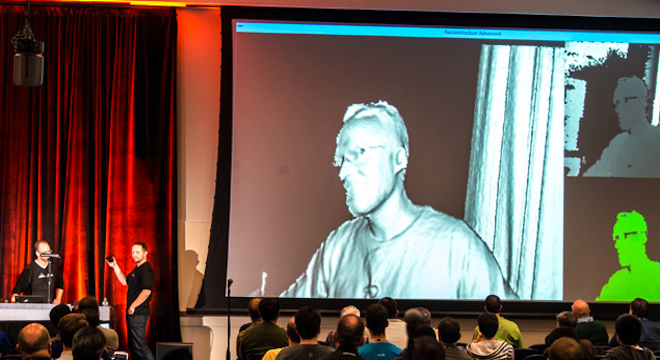Microsoft is bringing the ability to accurately scan 3D objects to the masses. On Monday, the company announced that it was working on a software update for its Kinect for Windows motion controller device that would turn it into such a scanner, allowing users to pick up their Kinects and move them around any 3D shape — from a person to a whole room — and create a 3D model of it on their computers.
The software is called “Kinect Fusion,” and was first developed by Microsoft Research in Cambridge in the United Kingdom.
Microsoft Research demoed Kinect Fusion’s eye-popping, incredibly detailed scanning capability in early October, producing a nearly exact reproduction of seminal scientist Isaac Netwon’s death mask, a process that was documented in the following video:
Microsoft also previewed Kinect Fusion 3D scanning at its BUILD 2012 developers conference on its headquarters campus in Redmond, Washington.
But now Microsoft wants to give any third-party Kinect hacker and software developer the same power. As Chris White, Microsoft’s senior program manager for the Kinect for Windows program wrote in a blog post on Monday: “As soon as the Kinect for Windows community saw it [Kinect Fusion], they began asking us to include it in our SDK [software development kit]. Now, I’m happy to report that the Kinect for Windows team is, indeed, working on incorporating it and will have it available in a future release.”
White didn’t provide an exact date for when Kinect for Windows developers can expect to have access to Kinect Fusion, but he did go on to explain just how the software works:
Kinect Fusion takes the incoming depth data from the Kinect for Windows sensor and uses the sequence of frames to build a highly detailed 3-D map of objects or environments. The tool then averages the readings over hundreds or thousands of frames to achieve more detail than would be possible from just one reading. This allows Kinect Fusion to gather and incorporate data not viewable from any single view point. Among other things, it enables 3-D object model reconstruction, 3-D augmented reality, and 3-D measurements.
White also listed a number of potential uses for the Kinect Fusion software, including “3-D printing, industrial design, body scanning, augmented reality, and gaming.”
But the software could put other Kinect for Windows third-party developers in a bit of a bind, namely one French startup company called ManCTL, which has already developed Kinect 3D scanning software of its own, which it calls Skanect. Skanect has also already been used to 3D sprint scans of physical objects and people. Check out a video of ManCTL’s demo of its Kinect scanning software here (beginning minute 18:30):
TPM has reached out to Microsoft for more information on its Kinect Fusion software and will update when we receive a response.
Kinect for Windows is a PC-based spin-off of Microsoft’s wildly successful Kinect motion controller for the XBox 360, launched in November 2010, which has since gone on to sell over 18 million units. Microsoft was at first wary of hackers repurposing the gaming controller for their own innovative uses, but eventually embraced and now supports development of new uses for the Kinect.






